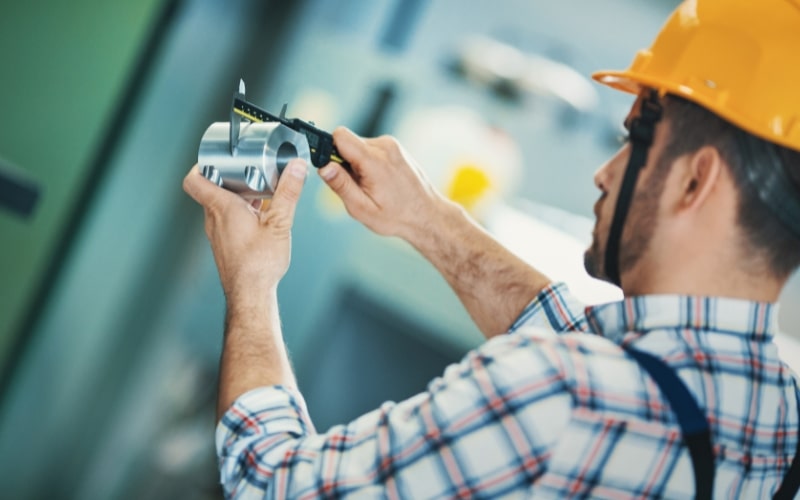- 1. Role Overview: Understanding the Quality Engineer's Responsibilities
- 2. Key Skills and Qualifications: What to Look For
- 3. Daily Tasks and Duties: A Day in the Life of a Quality Engineer
- 4. Tools and Technologies: Essential Equipment and Software
- 5. Career Development and Growth Opportunities
- Conclusion: Quality Engineer Job Description
The role of a Quality Engineer is integral to maintaining and enhancing the standards of excellence in manufacturing and production processes. When crafting a Quality Engineer Job Description, it’s essential to highlight that Quality Engineers are tasked with ensuring that products meet specific standards of quality, reliability, and performance.
Their responsibilities, as outlined in a well-developed Quality Engineer Job Description: What to Include, encompass a broad spectrum of activities, from developing quality control systems to conducting rigorous testing and inspections. This comprehensive role demands a blend of technical expertise, keen attention to detail, and robust problem-solving skills. By understanding the essential skills and qualifications required, the typical daily tasks and duties, the tools and technologies used, and the career development opportunities available, organizations can better appreciate the value that Quality Engineers bring to their operations.
1. Role Overview: Understanding the Quality Engineer’s Responsibilities

A Quality Engineer Job Description plays a pivotal role in maintaining the standards of excellence within a manufacturing or production environment. This professional is responsible for ensuring that products meet specific standards of quality, reliability, and performance before they reach the consumer. When crafting a Quality Engineer Job Description, it’s essential to highlight the multifaceted nature of the role, which involves tasks ranging from designing quality tests to troubleshooting issues and implementing improvements.
Core Responsibilities
At the heart of a Quality Engineer Job Description is the development and implementation of quality control systems. These systems are designed to ensure that products are manufactured consistently and meet predetermined standards. This Quality Engineer Job Description involves creating detailed test plans, setting quality benchmarks, and establishing inspection criteria. The Quality Engineer must also ensure that these quality control systems comply with relevant industry standards and regulations.
A significant part of the Quality Engineer Job Description involves conducting rigorous testing and inspections throughout the production process. This includes everything from the initial inspection of raw materials to the final product testing. Quality Engineers use a variety of testing methods and tools to identify defects or deviations from standards. When a problem is detected, they analyze the root cause and work with the production team to implement corrective actions.
Collaboration and Communication
Effective communication and collaboration are crucial in the role outlined in the Quality Engineer Job Description. They frequently interact with other departments, such as production, engineering, and supply chain, to ensure that quality standards are understood and met. This collaboration often involves training staff on quality control procedures and best practices. By fostering a culture of quality, as highlighted in the Quality Engineer Job Description, the Quality Engineer helps to prevent issues before they arise and promotes continuous improvement across the organization.
The Quality Engineer Job Description also emphasizes the responsibility for compiling and analyzing quality data to identify trends and areas for improvement. They use statistical analysis to monitor the performance of quality control systems and provide recommendations based on their findings. This data-driven approach helps to ensure that quality improvements are based on concrete evidence and lead to measurable results.
Regulatory Compliance
Ensuring compliance with industry regulations and standards is another critical aspect covered in the Quality Engineer Job Description. This involves staying up-to-date with changes in relevant laws and standards, such as ISO 9001 or specific industry certifications. The Quality Engineer Job Description also emphasizes the importance of aligning all quality control processes with these requirements and maintaining accurate and comprehensive documentation. This compliance not only helps to avoid legal issues but also enhances the credibility and reputation of the organization.
Problem-Solving and Innovation
Problem-solving is at the core of what a Quality Engineer does, and this is often highlighted in any detailed Quality Engineer Job Description. When quality issues arise, the Quality Engineer must quickly and effectively identify the root cause and develop solutions to address them. This requires strong analytical skills and the ability to think creatively. In addition to resolving current issues, the Quality Engineer Job Description often includes proactively identifying potential future problems and implementing preventative measures.
Innovation also plays a key role in the responsibilities of a Quality Engineer. They must continually seek out new methods and technologies to improve quality control processes. This might involve researching and implementing advanced testing techniques, investing in new equipment, or leveraging data analytics tools to gain deeper insights into quality performance. By staying ahead of industry trends and technological advancements, Quality Engineers ensure that their organization remains competitive and capable of delivering the highest quality products.
2. Key Skills and Qualifications: What to Look For

When crafting a Quality Engineer Job Description, it’s crucial to clearly outline the key skills and qualifications required for the role. A well-structured Quality Engineer Job Description not only helps attract the right candidates but also ensures that the selected individual can effectively fulfill the responsibilities of maintaining and improving product quality. Below are essential skills and qualifications to include:
Technical Skills
Understanding of Quality Standards A Quality Engineer Job Description must emphasize the need for a comprehensive understanding of various quality standards relevant to the industry, such as ISO 9001, Six Sigma, and Total Quality Management (TQM). Knowledge of these standards ensures that the engineer can develop and implement effective quality control systems that comply with industry regulations.
Statistical Analysis In a Quality Engineer Job Description, statistical analysis is a core skill that cannot be overlooked. Quality engineers must be adept at using statistical methods to analyze data, identify trends, and make data-driven decisions. Familiarity with statistical software, such as Minitab or JMP, is often essential. This skill helps in monitoring production processes and improving product quality.
Testing and Inspection Techniques Proficiency in various testing and inspection techniques is a key requirement in any Quality Engineer Job Description. This includes understanding different types of tests, such as destructive and non-destructive testing, as well as inspection methods like visual inspection, ultrasonic testing, and radiographic testing. The ability to select and apply the appropriate testing method is critical for identifying defects and ensuring product quality.
Root Cause Analysis A crucial aspect of any Quality Engineer Job Description is the ability to identify the root cause of quality issues. Quality engineers must be skilled in problem-solving techniques, such as Fishbone diagrams, 5 Whys, and Failure Mode and Effects Analysis (FMEA). These techniques help in diagnosing problems accurately and developing effective corrective actions.
Soft Skills
Attention to Detail
In a Quality Engineer Job Description, attention to detail is highlighted as a critical skill. This ensures that Quality Engineers can identify minute defects or deviations from standards that could impact product quality. Attention to detail is essential in maintaining high standards, as nothing can be overlooked during inspections and testing.
Problem-Solving Skills
The ability to solve problems is a key requirement in a Quality Engineer Job Description. Quality Engineers must quickly identify issues, analyze the root cause, and develop effective solutions. This role requires creativity, critical thinking, and the ability to handle unexpected challenges that may arise in the production process.
Communication and Collaboration
Effective communication is often emphasized in a Quality Engineer Job Description. Quality Engineers frequently interact with various departments, including production, engineering, and supply chain. They must clearly convey quality standards, provide training, and report on quality metrics. Collaboration is equally important, as improving quality often requires teamwork across different functions.
Organizational Skills
Organizational skills are another crucial aspect of a Quality Engineer Job Description. Quality Engineers must manage multiple tasks and projects simultaneously, including maintaining detailed documentation, managing inspection schedules, and keeping track of quality metrics. These organizational skills ensure that all aspects of the quality control process are well-managed and nothing is overlooked.
Educational Qualifications
Relevant Degree
A Quality Engineer Job Description typically specifies that candidates should hold a bachelor’s degree in engineering, manufacturing, or a related field. Common degrees listed in a Quality Engineer Job Description include mechanical engineering, industrial engineering, or materials science. These educational backgrounds provide a solid foundation in the technical aspects of quality engineering.
Certifications
Certifications can enhance a candidate’s qualifications as outlined in a Quality Engineer Job Description. Common certifications mentioned in a Quality Engineer Job Description include Certified Quality Engineer (CQE) from the American Society for Quality (ASQ), Six Sigma Green Belt or Black Belt, and Certified Quality Auditor (CQA). These certifications demonstrate a commitment to the profession and a high level of expertise in quality management practices.
Continuous Learning
The field of quality engineering is constantly evolving, and continuous learning is essential. Quality Engineers, as described in a Quality Engineer Job Description, should engage in ongoing professional development to stay current with the latest industry trends, technologies, and best practices. This can include attending workshops, conferences, and pursuing additional certification.
3. Daily Tasks and Duties: A Day in the Life of a Quality Engineer

The role of a Quality Engineer is dynamic and integral to maintaining high standards of product quality within a manufacturing or production environment. A thorough Quality Engineer Job Description highlights their daily tasks and duties, which are diverse, ranging from hands-on testing and inspections to data analysis and cross-departmental collaboration. Understanding the typical day of a Quality Engineer provides insighthttps://www.jrgpartners.com/mastering-recruitment-and-talent-management-in-the-new-normal-strategies-for-success/ into the multifaceted nature of this role and its critical importance in ensuring product excellence.
Morning: Planning and Coordination
The day for a Quality Engineer often begins with planning and coordination activities. This includes reviewing the production schedule and quality reports from the previous day to identify any pressing issues that need immediate attention. A typical morning might start with a team meeting where the Quality Engineer collaborates with production managers, engineers, and other stakeholders to discuss the day’s objectives, ongoing projects, and any quality concerns that have arisen. Understanding the Quality Engineer job description is crucial for effective collaboration and addressing these issues promptly.
During these meetings, the Quality Engineer provides updates on quality metrics and discusses any deviations from standards observed in recent production runs. This time is also used to plan inspections and tests that will be conducted throughout the day, ensuring that all necessary resources and personnel are aligned with the Quality Engineer job description.
Mid-Morning: Inspections and Testing
Following the initial planning phase, the Quality Engineer moves on to hands-on inspections and testing as outlined in the Quality Engineer Job Description. This involves conducting routine inspections of raw materials, in-process items, and finished products. Using a variety of testing methods—such as visual inspections, dimensional checks, and non-destructive testing techniques—the Quality Engineer assesses whether products meet specified quality standards.
During these inspections, detailed records are maintained to document the findings. Any identified defects or deviations from standards are noted, and the Quality Engineer may perform root cause analysis to determine why these issues occurred. This might involve using tools like Fishbone diagrams or conducting 5 Whys analysis to trace back the problem to its origin.
Afternoon: Data Analysis and Problem-Solving
The afternoon is often dedicated to data analysis and problem-solving. The Quality Engineer, as outlined in the Quality Engineer Job Description, reviews data collected from inspections and testing to identify trends and areas for improvement. Using statistical analysis software, they analyze this data to understand the performance of quality control processes and to pinpoint recurring issues.
When a quality issue is identified, the Quality Engineer works closely with the production team to develop and implement corrective actions. This may involve modifying production processes, adjusting quality control procedures, or providing additional training to staff. The goal is to resolve current issues and prevent similar problems from occurring in the future.
Late Afternoon: Documentation and Reporting
Documentation and reporting are critical components of a Quality Engineer Job Description. Towards the end of the day, the Quality Engineer compiles reports on the findings from inspections, tests, and data analysis. These reports are essential for maintaining accurate records and for communicating quality performance to senior management and other stakeholders.
The Quality Engineer also ensures that all quality documentation, such as inspection records, test results, and compliance reports, is updated and stored correctly. This documentation, as outlined in the Quality Engineer Job Description, is crucial for demonstrating compliance with industry standards and regulations, as well as for internal audits and reviews.
Continuous Improvement Initiatives
A significant part of a Quality Engineer’s role involves driving continuous improvement initiatives. Throughout the day, the Quality Engineer identifies opportunities for enhancing quality processes and systems. This might involve researching new testing methods, implementing advanced quality control technologies, or developing training programs for staff.
By staying abreast of industry trends and technological advancements, the Quality Engineer ensures that the organization continually improves its quality standards and remains competitive in the market. These continuous improvement efforts not only enhance product quality but also contribute to overall operational efficiency and customer satisfaction.
4. Tools and Technologies: Essential Equipment and Software

In the realm of quality engineering, the effective use of tools and technologies is paramount. Quality Engineers rely on a diverse array of equipment and software to perform their duties efficiently and accurately. These tools enable them to monitor, analyze, and improve product quality, ensuring that all standards are met. Below, we explore the essential tools and technologies that Quality Engineers use daily.
Inspection and Testing Equipment
Calipers and Micrometers Precision measurement tools such as calipers and micrometers are fundamental for Quality Engineers. These instruments are used to measure the dimensions of parts and components with high accuracy. Calipers are versatile tools that can measure internal and external dimensions as well as depths, while micrometers provide even more precise measurements, typically used for smaller tolerances.
Coordinate Measuring Machines (CMM) CMMs are advanced devices used to measure the physical geometrical characteristics of an object. They are essential for ensuring that parts meet design specifications. CMMs can measure complex shapes and surfaces with high precision and are often used in industries where tight tolerances are critical, such as aerospace and automotive manufacturing.
Non-Destructive Testing (NDT) Equipment NDT equipment is crucial for inspecting materials and components without causing damage. Techniques such as ultrasonic testing, radiographic testing, and magnetic particle inspection allow Quality Engineers to detect internal defects and irregularities. These methods are invaluable for ensuring the integrity and safety of critical components.
Quality Management Software
Statistical Process Control (SPC) Software SPC software is used to monitor and control manufacturing processes through statistical methods. This software helps Quality Engineers track process performance, identify variations, and implement corrective actions. Popular SPC software includes Minitab and JMP, which offer a range of tools for data analysis and visualization.
Quality Management Systems (QMS) QMS software, such as ISO 9001-compliant systems, provides a framework for managing quality processes across an organization. These systems help in documenting procedures, tracking non-conformances, and ensuring compliance with industry standards. QMS software integrates various quality control activities, making it easier for Quality Engineers to manage and improve quality processes.
Enterprise Resource Planning (ERP) Systems ERP systems, like SAP and Oracle, are comprehensive software platforms that integrate all aspects of a business, including quality management. These systems enable Quality Engineers to access real-time data, track quality metrics, and collaborate with other departments. ERP systems help streamline processes and improve overall operational efficiency.
Data Analysis and Reporting Tools
Statistical Analysis Software Quality Engineers use statistical analysis software to analyze quality data and identify trends. Software like Minitab, JMP, and IBM SPSS Statistics provide powerful tools for performing complex statistical analyses. These tools help Quality Engineers make data-driven decisions and implement effective quality control measures.
Data Visualization Tools Visualizing data is crucial for communicating quality performance and trends to stakeholders. Tools such as Microsoft Power BI, Tableau, and Excel offer robust data visualization capabilities. These tools enable Quality Engineers to create interactive dashboards, charts, and reports that convey insights clearly and effectively.
Root Cause Analysis Tools Root cause analysis tools, such as Fishbone diagrams (Ishikawa diagrams) and 5 Whys analysis, are essential for identifying the underlying causes of quality issues. These tools help Quality Engineers systematically investigate problems and develop effective corrective actions. Software applications that support these methodologies enhance the efficiency and accuracy of root cause analysis.
Emerging Technologies
Artificial Intelligence (AI) and Machine Learning (ML) AI and ML are transforming quality engineering by enabling predictive analytics and automated quality control. These technologies can analyze large datasets to identify patterns and predict potential quality issues before they occur. AI-driven quality control systems can also automate inspection processes, increasing accuracy and efficiency.
Internet of Things (IoT) IoT technology connects devices and systems, providing real-time data on production processes. IoT-enabled sensors and devices can monitor various parameters, such as temperature, pressure, and humidity, ensuring optimal production conditions. Quality Engineers can use IoT data to detect anomalies and prevent quality issues in real time.
5. Career Development and Growth Opportunities

The career path of a Quality Engineer is filled with numerous opportunities for professional growth and development. As industries continue to emphasize the importance of quality assurance and control, the demand for skilled Quality Engineers remains robust. Understanding the career development and growth opportunities available can help aspiring Quality Engineers plan their career trajectory and maximize their potential within the field.
Entry-Level Opportunities
At the entry-level, Quality Engineers typically start as Quality Assurance (QA) Technicians or Junior Quality Engineers. These roles involve hands-on tasks such as conducting inspections, performing tests, and collecting data. Entry-level positions provide a solid foundation in the basics of quality control processes and standards. During this stage, professionals gain valuable experience in using various testing equipment and quality management software.
Professional Certifications
As Quality Engineers progress in their careers, obtaining professional certifications can significantly enhance their qualifications and open up new opportunities. Certifications such as Certified Quality Engineer (CQE) from the American Society for Quality (ASQ), Six Sigma Green Belt, or Black Belt, and Certified Quality Auditor (CQA) are highly regarded in the industry. These certifications demonstrate a commitment to the profession and a high level of expertise in quality management practices. They also provide Quality Engineers with the knowledge and skills needed to tackle more complex quality challenges and take on greater responsibilities.
Mid-Level Roles
With a few years of experience and relevant certifications, Quality Engineers can advance to mid-level roles such as Senior Quality Engineer or Quality Manager. In these positions, professionals take on more strategic responsibilities, including designing and implementing quality control systems, leading quality improvement projects, and managing teams of QA technicians. Mid-level roles often require strong leadership and project management skills, as well as the ability to analyze data and make data-driven decisions.
Specialization Opportunities
Quality Engineers can choose to specialize in specific areas of quality management, such as supplier quality engineering, process improvement, or regulatory compliance. Specializing allows professionals to develop deep expertise in a particular domain and become valuable assets to their organizations. For instance, Supplier Quality Engineers focus on ensuring that materials and components from suppliers meet quality standards, while Process Improvement Engineers work on optimizing production processes to enhance efficiency and reduce defects.
Senior and Executive-Level Roles
At the senior and executive levels, Quality Engineers can move into roles such as Quality Director, Vice President of Quality, or Chief Quality Officer (CQO). These positions involve overseeing the entire quality management function within an organization and developing long-term quality strategies. Senior and executive-level roles require a comprehensive understanding of the industry, strong leadership abilities, and the capacity to drive cultural change towards a quality-centric organization. Professionals in these roles are responsible for aligning quality objectives with overall business goals and ensuring that the organization maintains its reputation for excellence.
Continuous Learning and Professional Development
Continuous learning is a key aspect of career development for Quality Engineers. The field of quality engineering is constantly evolving, with new technologies, methodologies, and industry standards emerging regularly. Quality Engineers must stay up-to-date with these changes through ongoing professional development. This can include attending workshops, conferences, and training programs, as well as pursuing advanced degrees in quality management or related fields. Engaging in continuous learning not only enhances a Quality Engineer’s skill set but also demonstrates a commitment to professional growth and excellence.
Networking and Professional Associations
Joining professional associations, such as the American Society for Quality (ASQ), can provide Quality Engineers with valuable networking opportunities and access to resources for career development. These associations offer conferences, webinars, and certification programs that help professionals stay current with industry trends and best practices. Networking with peers and industry leaders can also lead to mentorship opportunities, career advice, and potential job openings.
Conclusion: Quality Engineer Job Description
In conclusion, Quality Engineers play a pivotal role in upholding the quality standards that define an organization’s products and services. Their ability to blend technical knowledge with practical skills ensures that production processes run smoothly and efficiently, leading to the consistent delivery of high-quality products.
The diverse responsibilities of a Quality Engineer—from daily inspections to strategic quality management—highlight the importance of this role in any manufacturing or production setting. As they navigate their career paths, Quality Engineers have numerous opportunities for growth and specialization, underscoring the dynamic and evolving nature of the field. By investing in continuous learning and professional development, Quality Engineers not only enhance their own careers but also contribute significantly to the long-term success and reputation of their organizations. Learn about How To Hire Engineers.


